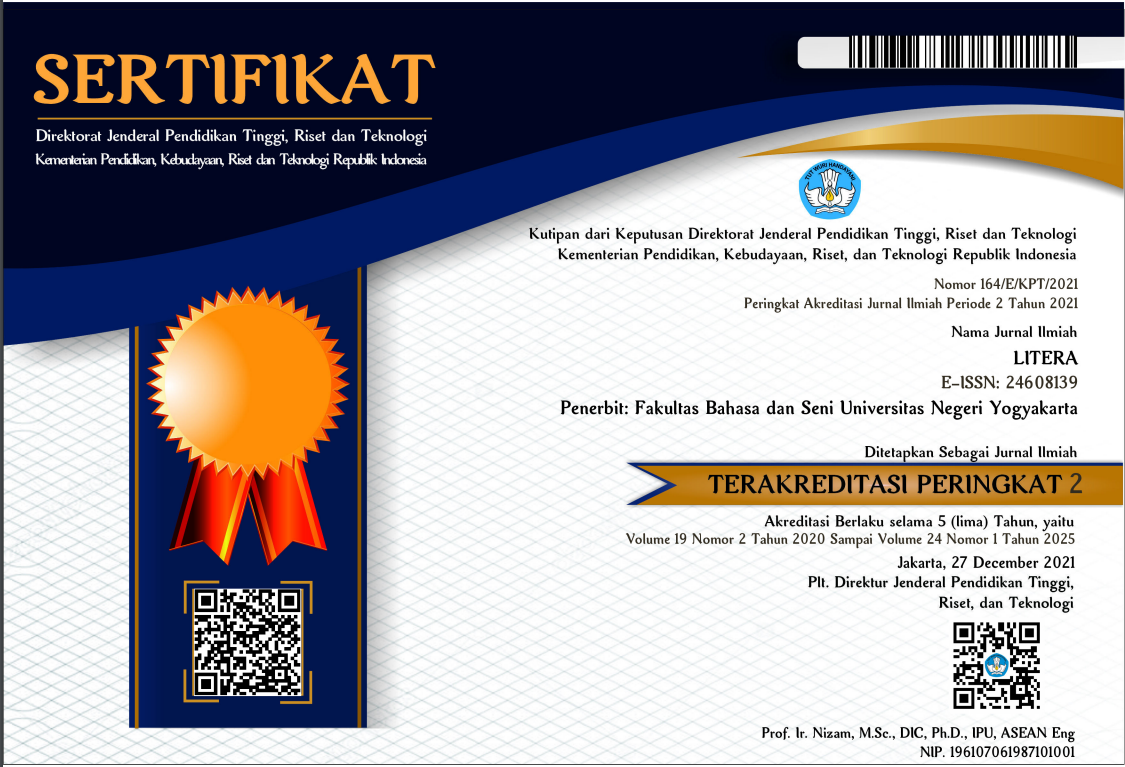PREDIKAT KOMPLEKS DALAM BAHASA ANGKOLA MANDAILING
Downloads
Predikat kompleks terbentuk ketika dua atau lebih elemen predikat bergabung ke dalam hubungan subjek dan objek. Penelitian tentang predikat komplek bahasa Angkola Mandailing merupakan media mempelajari bahasa daerah yang mulai ditinggalkan. Penelitian ini bertujuan mendeskripsikan konstruksi predikat kompleks bahasa Angkola Mandailing. Penelitian menggunakan pendekatan kualitatif dengan metode interaktif dengan teori X-bar. Sumber data penelitian adalah tuturan lisan informan dalam situasi tutur yang alamiah. Pengumpulan data dengan metode simak atau observasi. Analisis dilakukan selama pengumpulan, reduksi, penyajian, dan penarikan simpulan/verifikasi. Analisis data menggunakan metode agih dan disajikan menggunakan metode informal. Hasil penelitian sebagai berikut. Pertama, karakteristik predikat kompleks dalam bahasa Angkola Mandailing, yaitu dibentuk dari dua verba atau lebih, letaknya berdampingan, dan memiliki kesamaan aspek dan negasi. Kedua, pola pembentuk predikat kompleks dalam bahasa Angkola Mandailing berupa V1 intransitif + V2 intransitif, V1 transitif + V2 intransitif, V1 intransitif + V2 transitif, dan V1 transitif + V2 transitif. Ketiga, kedua verba atau lebih dalam konstruksi predikat kompleks bahasa Angkola Mandailing sama-sama menjadi verba inti dalam kalimat. Skema X-barnya ialah predikat kompleks (V1+V2) berkombinasi membentuk V'. V' membentuk FV. FV berkombinasi dengan I membentuk I'. I' berkombinasi dengan Spes membentuk FI (kalimat).
Kata Kunci: konstruksi, predikat kompleks, bahasa Angkola Mandailing
COMPLEX PREDICATION IN ANGKOLA MANDAILING LANGUAGE
Abstract
Complex predicates are formed when two or more predicate elements are joined into the relationship of subjects and objects. Research on the complex predication of the Angkola Mandailing language is a medium for learning the languages of the region that are becoming obsolete. This study is aimed at describing the complex construction of the Angkola Mandailing language. The study uses a qualitative approach with interactive methods with the X-bar theory. The source of the research data is the oral speech of informants in natural speech situations. Data collection is done by listening or observing. The analysis is carried out during the collection, reduction, presentation, and conclusion/verification research steps. Data analysis uses the aggregate method and is presented using the informal method. The results of this study indicate that first, the characteristics of complex predicates in the Angkola Mandailing language are formed from two or more verbs, located side by side, and having similar aspects and negations. Second, the complex predicate patterns are intransitive V1 + intransitive V2, transitive V1 + intransitive V1, intransive V1 + transitive V2, and transitive V1 + transitive V2. Third, the two or more verbs in the construction of the complex predicate together become the core verbs in the sentence. The X-bar scheme is a complex predicate (V1+V2) combined to form V '; V 'forms VP; VP combines with I to form I '; and I 'combines with Spes to form IP (sentence).
Keywords: grammatical construction, complex predicate, Angkola Mandailing language
Downloads
Alsina, A., Bresnan, J., Sels, P.(1997). Complex Predicates. Stanford, CA: CSLI Publications.
Balusu, R. (2006). Complex Predicates in Telugu: A Computational Perspective. Makalah disajikan pada Seminar COLING 2012: Demonstration COLING. (Kay, M &Boitet, C., eds), EFL University, Mumbai, India. pp 1-8. https://www.aclweb.org/anthology/C12-3001.pdf.
Bukhari, N. (2009). A Comparative Study of Gojri Double Verb Constructions. Language in India, 9(1), 27-51. http://www.languageinindia.com/jan2009/doubleverbgojri.pdf.
Butt, M. (2013). Complex Predicate Puzzles. Makalah disajikan pada Workshop Approaches to Complex Predicates. University of Konstanz, Paris, May 29–31. https://www.ling.uni-konstanz.de/typo3temp/secure_downloads/82191/0/8710d896f59e60896f41c1882246f4d0d72ec32c/paris13-cps.pdf.
Culicover, P.W. (1997). Principtes and Paramaters: An tntroduction to Syntactic Theory. Oxford: Oxford University Press.
Ehineni, T.O. (2014). A Syntactic Analysis of Lexical and Functional Heads in Nigerian English Newspaper Headlines. International Journal of Linguistics, 6(5), 9-21. http://www.macrothink.org/journal/index.php/ijl/article/view/6110.
Gultom, J. (2018, 21 Februari). Pelestarian Bahasa Ibu (Bahasa Daerah) Melalui Media Sosial. http://www.medanbisnisdaily.com/news/online/read/2018/02/21/26170/pelestarian_bahasa_ibu_bahasa_daerah_melalui_media_sosial/.
Hendrickx, I, et al. (2010). Complex Predicates Annotation in a Corpus of Portuguese. Makalah disajikan pada Fourth Linguistic Annotation Workshop ACL. Uppsala, Sweden. Hal 100-108. https://www.clul.ulisboa.pt/files/anagrama/CPportfinal.pdf.
Kumar, R. (2013). Agreement in Magahi Complex Predicate. International Journal of Linguistics, 5(1), 176-190. http://www.macrothink.org/journal/index.php/ijl/article/view/3304.
Li, W. (2013). Lexicalisation Patterns of Complex-Predicate Constructions in Japanese. International Journal of Linguistics, 5(4), 178-187. http://www.macrothink.org/journal/index.php/ijl/article/view/3989.
Moleong, J.L. (2014). Metode Penelitian Kualitatif , Edisi Revisi. PT Remaja Rosdakarya, Bandung.
Mulyadi. (2010). Frasa Preposisi Bahasa Indonesia: Analisis X-Bar. Jurnal kajian sastra, 34(1), 1-12. http://ejournal.undip.ac.id/index.php/kajiansastra/editor/submission/2671.
Miles, M.B., Huberman, M., Saldaña, J. (2014). Qualitative Data Analysis: A Methods Sourcebook (edisi 3). Thirdedition. Sage: London.
Nilu & Rajesh, K. (2012). Phrasal Integrity in Magahi Complex Predicates. OSR Journal of Humanities and Social Science (JHSS), 3(1), 25-30. DOI: 10.9790/0837-0312530.
Oktaviana, D., & Mukhlish. (2015). Verba Serial dalam Bahasa Indonesia. Jurnal Caraka, 1(2), 50-58. http://jurnal.ustjogja.ac.id/index.php/caraka/article/view/1915/1081.
Pantcheva, M. (2009). First Phase Syntax of Persian Complex Predicates: Argument Structure and Telicity. JSAL, 2(1), 53-72. https://ojs.ub.uni-konstanz.de/jsal/index.php/jsal/article/view/7.
Ramchand, G. (2008). Verb Meaning and the Lexicon: A First Phase Syntax. Cambridge: Cambridge University Press.
Subiyanto, A. (2010). Konstruksi Verba Beruntun dalam Nona Koelit Koetjing. Makalah disajikan pada Seminar Nasional Pemertahanan Bahasa Nasional. Universitas Diponegoro, Semarang. Hal 176-184. https://core.ac.uk/reader/11735325.
Sudaryanto. (1993). Metode dan Aneka Teknik Analisis Bahasa. Yogyakarta: Duta Wacana UniversityPress.
Zahra, T.S. & Mulyadi. (2019). Kalimat Tanya dalam Bahasa Mandailing: Teori X-Bar. Retorika: Jurnal Bahasa, Sastra, dan Pengajarannya, 12(2), 235–242. https://ojs.unm.ac.id/retorika/article/view/9315.
























